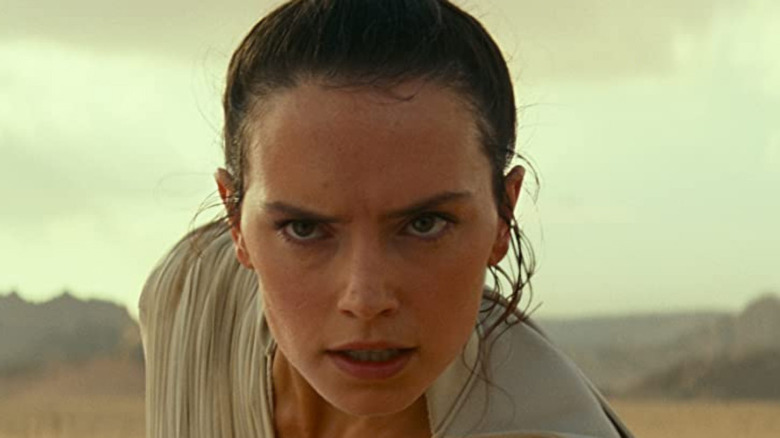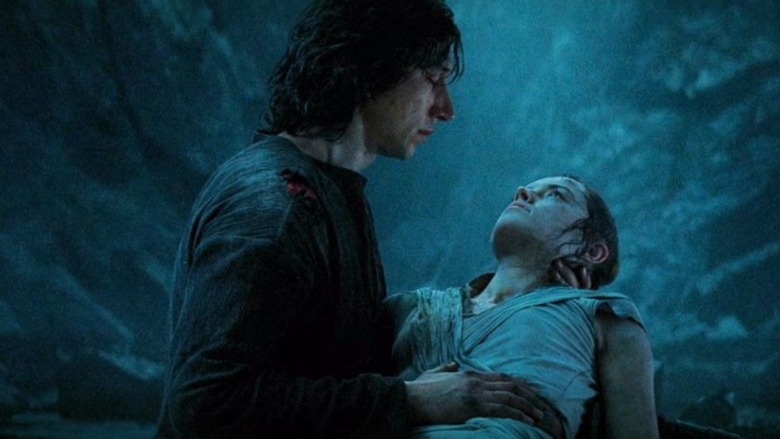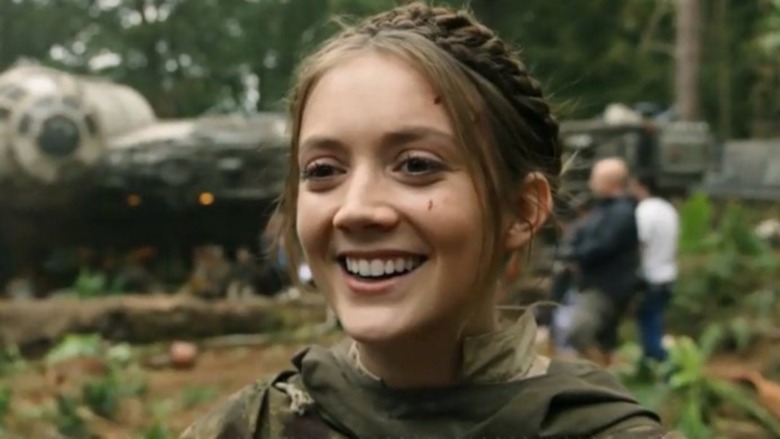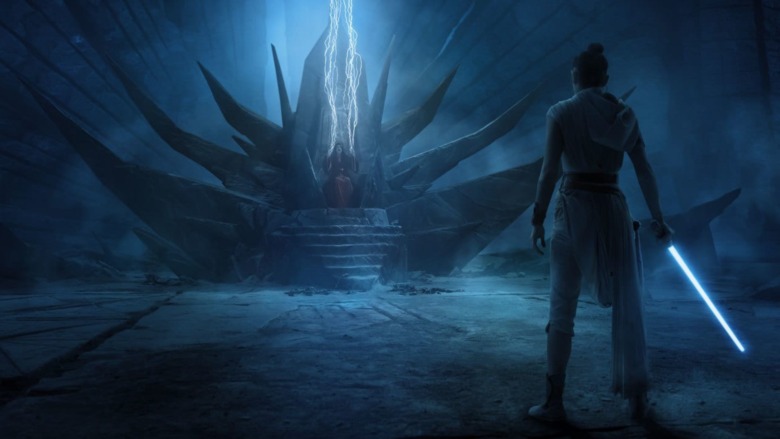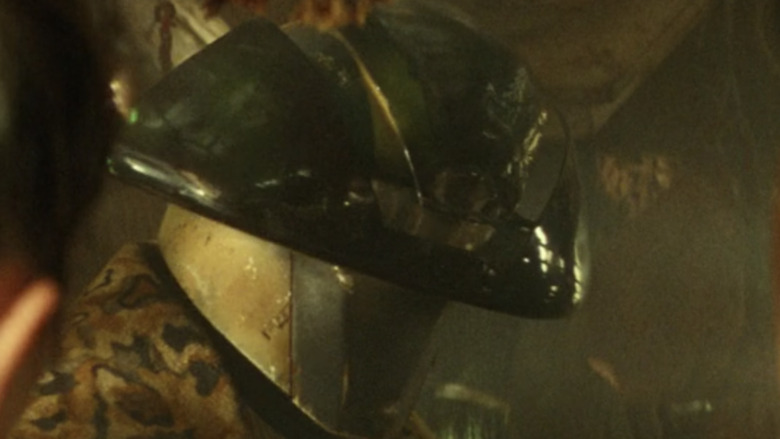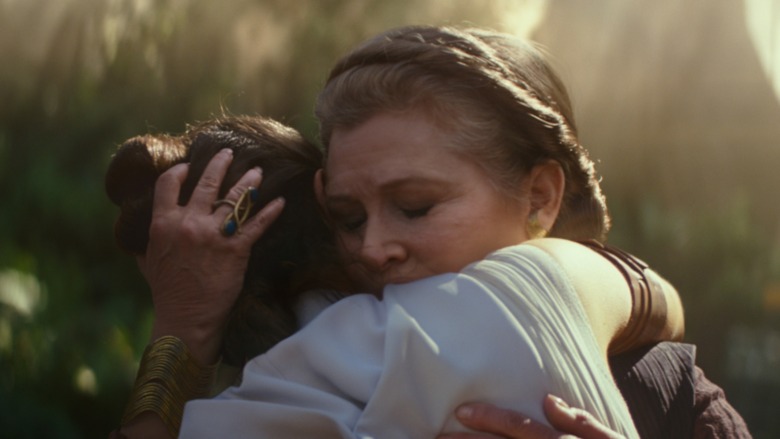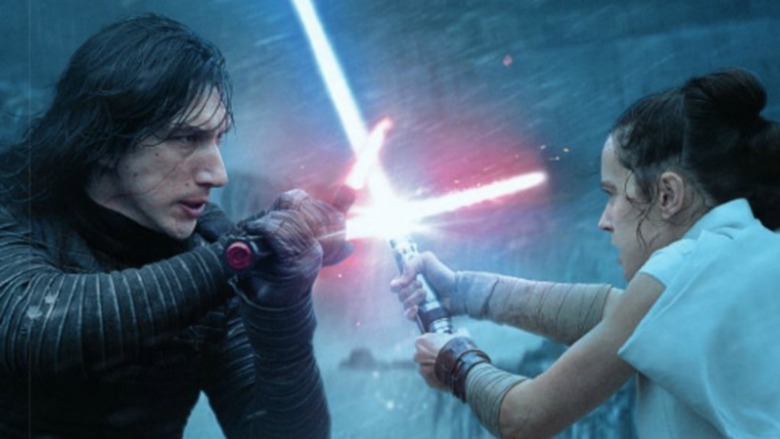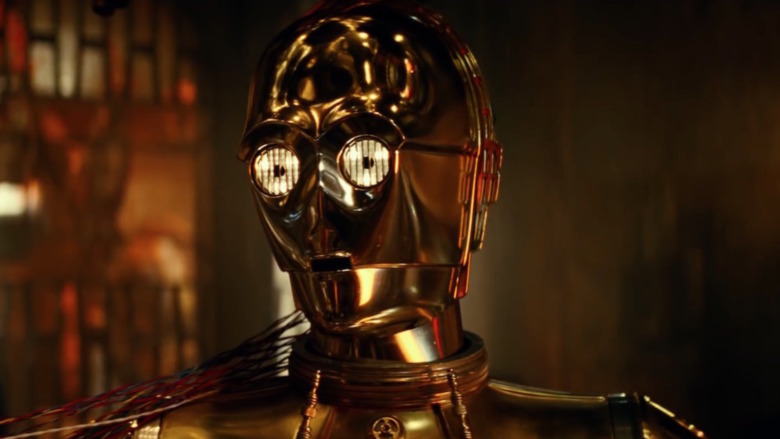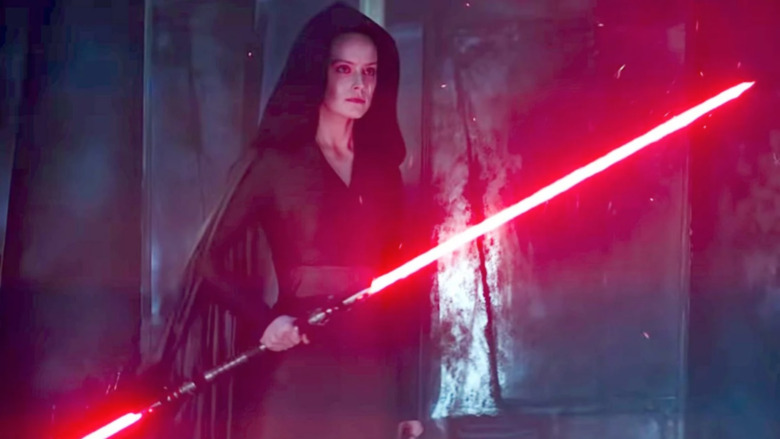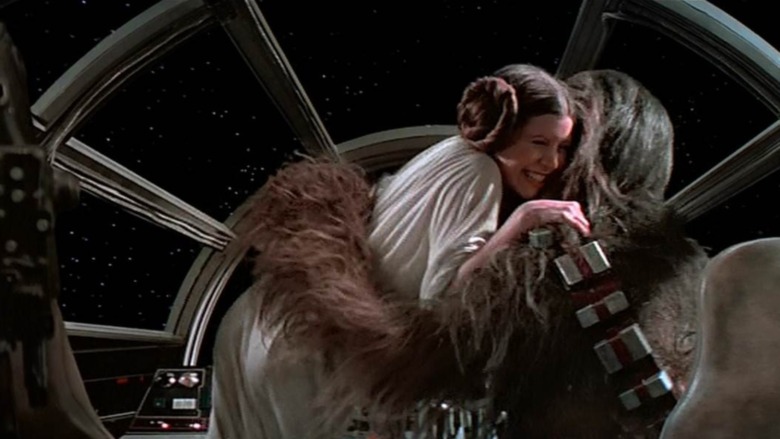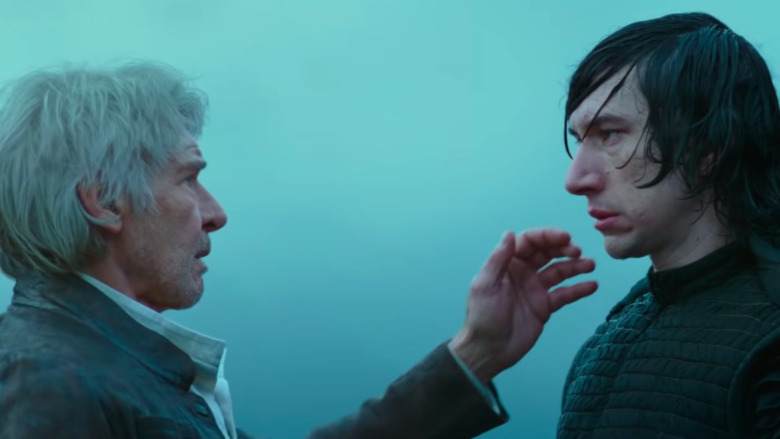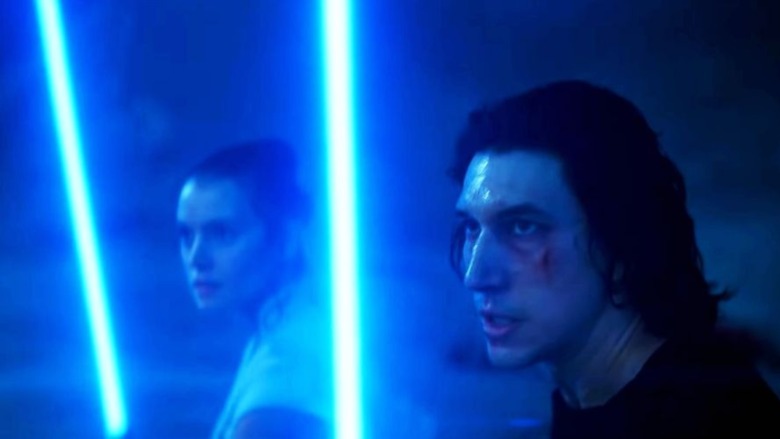Things You Only Notice In Rise Of Skywalker After Watching It More Than Once
Emotions spiraled everywhere when fans first lined up to see "Star Wars: The Rise of Skywalker," the epic finale to the Skywalker storyline some have been following since "A New Hope" came out in 1977. Well ... it's sort of a finale, anyway. At the time, Disney announced that the film would be the ending of the Skywalker saga, but since then, Disney+ has announced TV projects like "Obi-Wan Kenobi" and "Lando." While we're certainly not complaining that angsty Anakin might get to redeem himself, "The Rise of Skywalker" hits differently, now that we know it's not really the end for many characters we know and love.
Watching "The Rise of Skywalker" for the first time was a raw experience for many. This made it easy to miss subtle nuances, callbacks, and moments of character development splashed throughout the story. Whether you love or loathe the movie, you may have missed some of these moments during your first watch of "The Rise of Skywalker." We're here to catch you up.
Like grandfather, like grandson
"Star Wars" fans have all heard this threat before: "Come to the Dark Side or die." Just add in a couple of "mwahahas," and you've got yourself a Sith Lord. In "A New Hope," Darth Vader gives his own version of the Sith Lord Recruitment Speech, but as we know, Luke spurns his offer. Despite Vader's threat, however, the bonds of family are strong enough to eventually break the Dark Side's hold on him, allowing Vader to sacrifice himself for his son. In "The Rise of Skywalker," Kylo Ren follows in his granddaddy's footsteps by threatening Rey with death for refusing to yield to darkness. He says, "Such pain in you. Such anger. I don't want to have to kill you. I'm going to find you, and I'm going to turn you to the Dark Side. When I offer you my hand again ... you'll take it."
Yet in Kylo's dramatic attempts to become his grandfather (remember him playing Hamlet with his melted helmet?) at his most evil, he actually ends up mirroring Vader's heroic redemption. Vader and Kylo not only save the person they initially threaten, they both give their lives for that very same person. Kylo foreshadows sacrificing his life for Rey the minute he mimics Vader's speech from all those years ago. And while Anakin probably isn't proud of all the destruction his grandson causes in his name, he can finally be proud of him for the selfless sacrifice he makes.
Two princesses in a pod
Carrie Fisher's legacy within the "Star Wars" universe is a glittering beam of light, brighter than Tatooine's dual suns. In the sequel trilogy, Fisher's daughter Billie Lourd captures Leia's glow with aplomb. Of course, having the mother-daughter duo on set together meant "Star Wars" Easter eggs galore — especially in the hair department. Lourd revealed that Fisher demanded that her character, Lieutenant Connix, wear a version of Fisher's iconic cinnamon bun hairstyle in a beautiful essay for TIME, published a few years after her mother's death. However, the hairstyle references don't stop there.
Given that almost every scene featuring Lourd also features Fisher in "The Rise of Skywalker," most fans had their eyes glued on Leia. But if you keep your eyes locked on Lourd, you just might notice something: Leia's braided look from "Return of the Jedi." As with Connix's buns from the first sequel movie, the 'do is not a perfect recreation of the "Jedi" look — it features a messier bun in the back. But it's undoubtedly an homage to our favorite space princess-turned-general.
Even Connix's clothes are reminiscent of Leia's Endor duds, a throwback that will make just about anyone tear up. What's more, both films mark the final film in a trilogy, and the celebration of a Rebellion win. As the late General Organa says, " Hope is like the sun. If you only believe it when you see it, you'll never make it through the night."
The origin story (re)awakens
At second glance, the bombshell that Rey is Palpatine's granddaughter isn't exactly subtle. Yes, Kylo's throwaway line retconning his previous assertation that Rey's parents were nobodies is a bit of a clumsy maneuver. Yet J.J. Abrams' attempt to rewrite the events of Rian Johnson's "The Last Jedi" isn't without its own buildup. "The Rise of Skywalker" offers plenty of moments that foreshadow Rey's Palpatine connection — they're just much more noticeable after the big reveal happens.
When our favorite heroes gather around Poe to discover that good ol' Palpy has been (sort of) alive and kicking this entire time, Leia gives us our first clue. Because the film recycles unused Carrie Fisher footage from "The Force Awakens," fans have to suspend their disbelief a bit with the editing process. However, given the way Leia's scenes are cut together, it almost looks like she's staring right at Rey when Poe makes his announcement. Was that intentional? Probably.
Later, Rey displays lightning Force abilities when she battles Kylo on Pasaana. It seems irrelevant to Palpatine during the first go-around, because it's one moment in a series of scenes that build up Rey's wild Force abilities. Sure, Force lightning is a specific Palpatine trait, but you might not notice that while watching. In hindsight, though, it's clear that she got that particular characteristic from dear old grandpa.
'Send Leia my love'
It's nice to see the princess rescue her pseudo-prince once in a while — no wonder the moment Leia (almost) rescues Han in "Return of the Jedi" is iconic. Dressed to the nines in a Boushh disguise, Leia infiltrates Jabba's digs to unfreeze Han from his carbonite prison. If you didn't let out an excited gasp the first time you watched her remove her helmet, you're probably lying.
However, with the ninth film forced to be Leia-light due to the tragic death of Carrie Fisher, J.J. Abrams and company had to find subtle ways to honor our favorite space princess. During rewatches of "The Rise of Skywalker," it becomes clear that Billy Dee Williams' Lando Calrissian plays a big part in that effort.
Lando's epic intro scene in "The Rise of Skywalker" calls back to Leia in the best way. The former Baron Administrator of Cloud City wears a helmet disguise that looks a lot like Leia's Boushh get-up in "Return of the Jedi," only to take it off in a similarly triumphant way. Lando's entrance is also exciting on its own, given that we hadn't seen Williams take on the role in a live-action capacity since the film in which Leia catfishes Jabba. Shortly after he removes his helmet, he says, "Send Leia my love." The moment isn't blatantly obvious on an initial watch, but its intentions are clear upon revisiting the film.
Becoming a Skywalker
Rey's entire arc hinges on the young Jedi discovering who she is. She spends so much time thinking of a family she never knew that she doesn't fully embrace her found family — at least, not until "The Rise of Skywalker." When the rebels crash the Festival of the Ancestors on Pasaana, Rey tells Nambi Ghima that she doesn't know her last name. While the scene is clearly significant to the first-time viewer, its importance becomes even more evident upon rewatch.
Rey's unknown origin story and family history clearly still haunt her. This moment specifically foreshadows her choosing her own name — Skywalker — when she's asked the same question on Tatooine, at the end of "The Rise of Skywalker." The similarities between Leia and Rey are staggering, so it's not surprising that Rey's deep connection to her mentor would make her want to explicitly carry on the Skywalker legacy. However, Rey also has the chance to restore honor to the Skywalker name, which has become so deeply tarnished over the years. It takes a long journey for Rey to find herself, but she finally does, and it all ends with the words of a young alien and a little self-reflection.
The foreshadowing of the vexis
Perhaps more than any other character in the "Star Wars" universe, Rey opts to see the good in things. She frequently risks her life, giving everyone and everything the benefit of the doubt, no matter the stakes — even when everyone else urges her to do otherwise.
After the gang gets sucked into quicksand on Pasaana, it becomes clear that everyone who has previously entered the vexis' home has perished at the hands (or fangs) of the snake-like creature. However, when Rey risks her life to save the injured beast, displaying healing Force magic, she's rewarded with free passage out of its cave. What's more, this scene directly parallels Kylo's redemption arc, foreshadowing one of the film's most significant moments.
Similarly to how she handled the vexis, Rey gives Kylo a non-fatal injury during their battle. She could have easily doled out a killing blow, but she chooses to believe in Ben Solo's goodness instead. Because of Rey's continued kindness in the wake of his violence, Kylo can see that there's still good in the world. Kylo has used the pain of his life to fuel his darkness, but Rey drains some of that anger, forcing Kylo to deal with his guilt. In the same way she did for the vexis, she heals Kylo, and he rewards her for it by saving her life (and later sacrificing his own).
Rey gives C-3PO autonomy
When Poe and Finn want to risk wiping C-3PO's memory for good in order to translate a Sith dagger, Rey does something shocking: She lets him weigh in. Specifically, she asks if they have a choice, to which he tilts his head back in surprise for a millisecond. No one ever really considers his thoughts or feelings in this way — in fact, we've never really seen C-3PO treated with any kind of dignity or respect before. Even R2-D2 tends to drag C-3PO around everywhere, without listening to his pal's objections on the matter. Almost every other droid in the "Star Wars" universe is treated better than the golden humanoid — and he knows it. Though his surprise is fleeting and minimal when Rey consults him, it's there.
Rey weighing in on the odds also directly counters Han's "Never tell me the odds" philosophy. Throughout the entire franchise, Han, and even Luke at times, generally treat C-3PO like an expendable nuisance, despite his loyalty. This marks the first time someone has given him any sort of autonomy, and with that blink-and-you-miss-it head tilt, we see how much it means. Finally, we see C-3PO make the right choice instead of running away, as he has historically been wont to do, because Rey actually allows him to make that choice for himself.
Dark inspires Light
Dark Rey may be more of a central focus in "The Last Jedi," but she gets her chance to shine (or, well, darken) in "The Rise of Skywalker" too. We see Dark Rey for a minute when Rey picks up the Wayfinder. The short vision initially seems to appear for drama's sake alone, but it just might have another purpose: inspiration.
No, not towards any Dark Side inclinations, as Rey never really walks that line. But we spend a good portion of the film watching Rey struggle to adapt to a typical lightsaber, as she's used to her staff. Much smaller in stature than the weapon she's familiar with, Rey's frustration even ends up hurting BB-8. So, clearly, something has got to give. At second glance, it seems like Dark Rey may have given our Rey the idea to model her future lightsaber after her staff. While Dark Rey's saber has a nunchuck-ish quality to it, it functions a lot like Rey's staff when it's at full mast. Of course, fans wouldn't notice the correlation in the moment, as Rey's massive, golden lightsaber reveal doesn't happen until the end of the film when she lays Leia and Luke's lightsabers to rest. However, it's easy to see where she gets the idea to stop fighting her instincts and honor what feels natural.
There's no grieving in war
Sure, "Star Wars" may seem like a fun, campy space story, but its darker connotations are right there in its name. It's not called "Star Peace," after all. In war, there are casualties — and the franchise certainly doesn't shy away from killing off fan-favorites.
Back in "A New Hope," we see Leia, who just watched her entire planet blow up, pause her grief, because she has a mission. It's not the first time she's lost someone to the war, but she loses her adoptive parents and her planet all in one fell swoop in Alderaan's destruction. Still, she keeps going, because she has to. She even takes time to comfort Luke, who's lost Obi-Wan (a guy he just met), ignoring her own grief.
In "The Rise of Skywalker," Chewbacca does the same thing. Chewie is utterly devastated when he learns of Leia's passing, letting out a chillingly grief-stricken howl. At this point, he too has lost everyone he loves — but his grieving is cut short without a word of objection. There's so much going on during this sequence that it isn't blatantly obvious, but the minute he's told that he's needed, Chewbacca immediately jumps up, nods, and goes into action, abandoning his pain for the cause. This small, seemingly insignificant call to action speaks to the trauma soldiers have to bury to carry on the mission. He and Leia are very similar in that way.
Ben and Han 'Swagger' Solo
Upon first learning of Kylo Ren's origin as Han and Leia's son in "The Force Awakens," audiences were stunned. Beneath all of Kylo's temper tantrums, it's difficult to see the smug smuggler and the diplomatic princess in him. Now, familial traits often skip a generation — he certainly has Anakin's characteristics on lock. Yet throughout the series, Kylo's decisions and mannerisms make it ever more difficult to buy into his Solo lineage — until "The Rise of Skywalker."
Viewers are infinitely more concerned with whether or not Rey will turn to the Dark Side and kill Palpatine when Ben strolls up with a new moral code and a fresh lease on life. Still, if you look closely, with a blaster in hand, he looks exactly like his father. For arguably the first time in the series, it's clear that Ben is Han's son: Brave, reckless, and full of swagger.
Everything from Ben's mannerisms to his facial expression to his jaunty stride are reminiscent of Han in the original trilogy. Appearance-wise, Han and Ben don't look all that related (save for maybe the nose), so it's nice to see some characteristics come out after Ben ditches his evil alter ego. The scene is made even sweeter by the closure and forgiveness Ben received earlier, in what was either a hallucination or an image sent from Leia on her deathbed.
Lightsabers and legacies
Few things tell you more about a Jedi than their lightsaber, and the ones Rey and Ben wield when they battle Palpatine have much deeper meaning than might be apparent. When Rey equips a newly good Ben Solo with one of the Skywalker sabers, it's difficult to tell who has Luke's and who has Leia's. However, on closer inspection, it becomes clear that Rey handed off Luke's lightsaber and kept Leia's for this high-stakes battle.
When Ben becomes willing to fight with Luke's lightsaber, leaving his petty revenge behind, it solidifies his redemption arc. Finally, he achieves closure and forgiveness when it comes to his uncle and old Jedi Master. He's long blamed Luke for his descent to the Dark Side, but in this moment, he's finally able to move on.
For Rey, wielding Leia's lightsaber is similarly significant. It symbolizes that while we may have lost the strongest and most brilliant woman in the galaxy, Leia's spirit lives on in her powerful and deeply moral successor. While the young Jedi was certainly close with Luke as well, Rey is everything Leia might have hoped for in a daughter. When Rey takes her surrogate mother's last name, she truly becomes that child Leia never had. And let's face it: Nothing ever ends well when it comes to the Skywalker men. It's only fitting that a woman is given the chance to carry on the legacy. We need less Anakin energy and more Leia energy in the galaxy.
